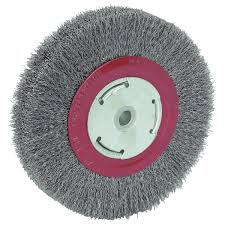
Wire brushes are some of the most common industrial finishing tools on the market and can be used for a number of applications. iAbrasive.com distributes wire brushes into great varieties based on different shapes and application.
Wire brushes are some of the most common industrial finishing tools on the market and can be used for a number of applications. iAbrasive.com distributes wire brushes into great varieties based on different shapes and application, including wire wheels, cup brushes, end brushes, bevel brushes, tube brushes, honing brushes, scratch brushes, bristle brushes, and more. iAbrasive.com has all types of wire brushes for users' application.

Wheel brushes are ideal for deburring machined castings, turbine blades, cam shafts, machined parts, edges on saw-cut extrusions, powdered metal components and gears, part finishing and sharpening for cutting tool inserts, edge radiusing on parts, surface finishing on steel, stainless steel, aluminum, brass and other materials, light cleaning and polishing for ferrous and non-ferrous parts.

Disc brushes are used for deburring fine-blanked parts, edge radiusing on fine-blanked parts, polishing machined parts and surfaces, deburring cast engine blocks, airframe components, wheel rims, tubing and aluminum extrusions, blending tool marks and finishing flat machined surfaces, generating specific edge radii on tooth profiles of machined gears, surface preparation and finishing on metal and wood, deburring and finishing cast aluminum wheel rims, deburring and edge radiusing aluminum engine heads, removing burrs and sharp edges on machined flat surfaces of cast aluminum engine intake manifolds, surface finishing and burr removal on hydraulic components, rust and scale removal, scrubbing and cleaning steel and aluminum sheets, clean pre-cast concrete molds, finishing surfaces prior to painting, plating or powder coating, sanding and texturing wood surfaces.

Bristle brushes are flexible and conform to irregular surfaces. You can expect a consistent finish even on the most complex parts. Because they contain no wire filaments, they help customers meet increasingly tough safety standards.
Major wire types of wire brushes include straight wire, crimped wire, and twist-knotted wire. Crimped wire brushes are best suited for appearance finishing, edge blending, cleaning and polishing of internal and external tube diameter surfaces as well as irregular external surfaces. Crimping of wire bristles in wire brushes is done for two major reasons:

1. Crimping makes the wires stand apart from each other
2. Crimping absorbs the flexing and vibrations and also helps to prevent wire fatigue and breakage
Twist-Knotted Wire Brushes

When heavy brushing action is necessary, knotted wire brushes are a great alternative. These wire brushes possess durable cutting action for cleaning applications. Because of their knotted bristles or tufts, these wire brushes are more rugged making the cutting action more aggressive. The tufts will also absorb the vibration which helps eliminate the bending and, therefore, reduce wire fatigue. In addition, with the top third of the knotted bristles being slightly flared, the design of knotted wire brushes is the reason why they are able to sustain an aggressive cutting action. One of the most common applications for knotted wire brushes today is in oil fields where heavy brushing action is required.
Twisted brushes are used for deburring cross-hole intersections in machined valve bodies and manifolds, deburring camshaft bores and crankcase bores, debris removal and cleaning internal bores on cast engine blocks, finishing and polishing small inside diameter holes on machined parts, deburring and cleaning inner walls of tubing and pipes.
Author: Liwei Chu
Copyright: iAbrasive.com--Abrasives & Diamond Tools Market